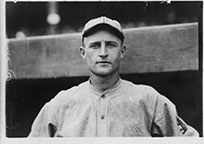October 14, 1928 Age 37
The Brooklyn Citizen
Burleigh Grimes, Clarence Mitchell, . “Red” Faber and Old Jack Quinn Now Only “Spitters” in Major League
The ranks of spitball pitchers in the majors are dwindling yearly.
The Brooklyn Club the other day announced the unconditional release of Bill Doak, an advocate of the moist ball, who long has been one of the leading hurlers in the National League.
Surviving Doak as spitball pitchers in the majors are Clarence Mitchell, of the St. Louis Cardinals; “Red” Faber, of the Chicago White Sox; Burleigh Grimes, former Brooklyn and New York Giant star and now with the Pittsburg Pirates, and Jack Quinn, veteran moundsman of the Philadelphia Athletics.
Doak has just closed a career that is unusual in its nature. He was a member of the St. Louis Cardinals’ staff from 1913 to 1923. His pitching effectiveness was the talk of baseball scribes tor the season of 1914.
That year Doak had a record of winning nineteen games and six defeats. The average earned run per game was 1.72, which established him as being one of the leading pitchers in the majors.
In 1916, Doak won twelve games and lost eight for the St. Louis team with an average for earned runs being 2.62. In 1920 he turned in twenty victories in thirty-nine starts and achieved a record of fifteen victories against six defeats in 1921.
Came to Brooklyn
Wilbert Robinson, manager of the Brooklyn Dodgers, thought enough of Doak to trade Leo Dickerman, at the time a promising pitcher, for the St. Louis ace. Dickerman had won twenty-two games for Memphis in 1922 and was regarded as the brightest prospect in the minors. The 1924 season found the Dodgers battling the New York Giants for the supremacy of the National League. Every four years the Dodgers had been considered the leading contender for the title.
Doak pitched great ball, following the mid-season trade and was extremely effective against the Pirates and the Cubs. However the McGraw clan staged a strong finish to win the title and Doak never realized his life’s ambition to pitch in a world series game.
During 1925 and 1926 Doak remained out of baseball when Florida real estate claimed his attention. He rejoined the Dodgers in 1927 and finished the season with the team this year only to be released.
Rough on Reds
His baseball career is unique in that he has upon three occasions pitched almost perfect baseball. Doak would have been credited with hurling two no-hit games, but his failure to cover first base on slow grounders twice robbed him of this distinction. On another occasion, two hits in the ninth inning robbed him of a no-hit contest.
For the 1928 season he was used to an advantage against the Cincinnati Reds. Early in the season, Cincinnati was leading the league, but with Doak on the mound for the Dodgers, the Reds lost many games to the Flatbush team. Jack Hendricks no doubt received the news that Doak had been unconditionally released with great pleasure.
Doak was born in 1891 at Pittsburg. Like many of baseball’s famous figures his playing on amateur teams gained the attention of baseball scouts. At the age of nineteen, he joined the Wheeling, W.V. club of the Central League.
Elsewhere in Sports: Boxer Gene Tunney’s fiancé, Polly Lauder, playing deck tennis on the MS Saturnia in 1928 while sailing to meet her husband-to-be.

